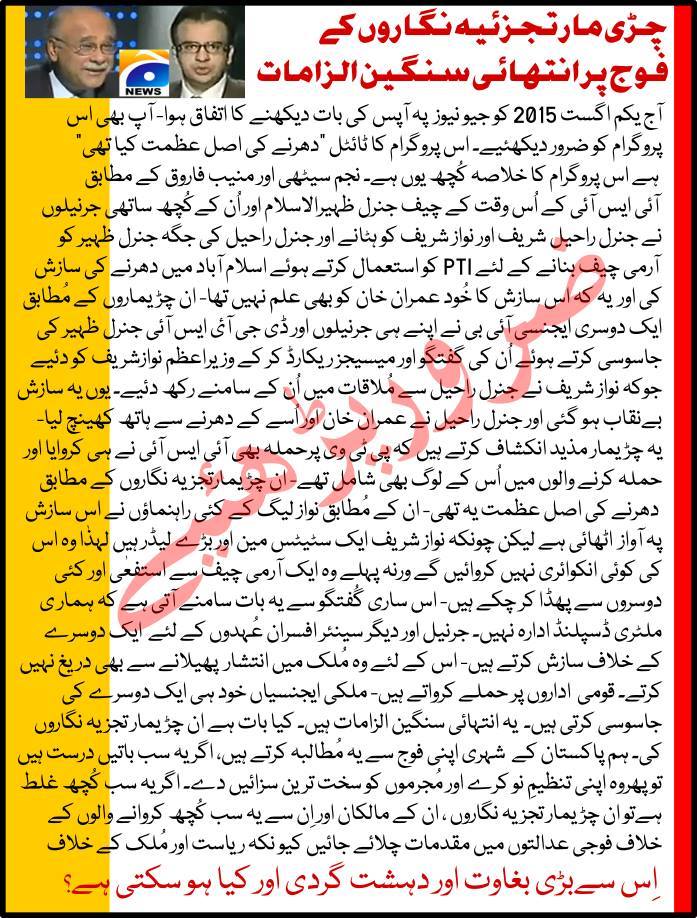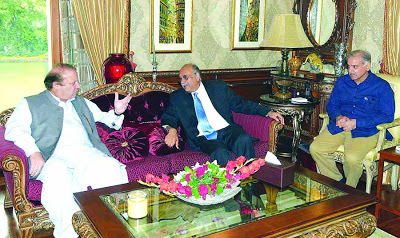Appeal to General Raheel Sharif: Investigate Najam Sethi’s extremely serious charges against Pakistan army and ISI
In his talk show on Jang Group’s Geo News TV (1 Aug 15), journalist Najam Sethi alleged that Pakistan army, ISI in particular, was involved in a conspiracy to dislodge PM Nawaz Sharif and army chief General Raheel Sharif.
Aapas Ki Baat – 1st August 2015
Sethi and his assistant Muneeb Farooq alleged that ISI’s ex-Chief General Zaheer-ul-Islam and some other generals were part of a conspiracy, in collusion with Imran Khan, to remove not only PM Nawaz Sharif but also General Raheel Sharif and replace him with another General, possibly General Zaheer himself as the new army chief. In the past, Sethi has levelled somewhat similar charges against ex-ISI chief General Ahmad Shuja Pasha.
In the said episode of Aapas ki Baat, Sethi alleged that it was the ISI, along with ordinary PAT and PTI workers of Dr Tahir ul Qadri and Imran Khan, who attacked the PTV, Pakistan’s State television network.
Sethi further claimed that a civilian intelligence agency IB (Intelligence Bureau) provided phone tapes of the ISI chief and other individuals’s conversations to PM Nawaz Sharif who then shared the same with General Raheel Sharif.
These are extremely serious charges that need to be investigated at the highest level.
1. Najam Sethi is a controversial journalist, known for his loyalties to PM Nawaz Sharif and some foreign donors. He has been continuously compensated by the ruling party PML-N for his ‘favourable’ role during elections 2013 – rewarded in the shape of lucrative posts in Pakistan Cricket Board and elsewhere.
2. Sethi and some of his associates, eg Beena Sarwar and Tahir Ashrafi, are currently upset over the recent elimination of Malik Ishaq along with 14 ASWJ-LeJ terrorists. It may be noted that Nawaz Sharifs’ PML-N is an informal ally and supporter of ASWJ-LeJ.
3. Sethi wants to paint a picture that army is an unprofessional institution, lacking discipline. A similar attempt was made by PM Nawaz Sharif in his previous tenure when he tried to dismiss the then army chief General Musharraf by creating divisions within army generals and corps commanders. Apparently, Nawaz Sharif and Sethi have not learnt from their past mistakes.
4. By bringing Pakistan army to disrepute and also by creating divisions within, the Saudi-loyalist PM Nawaz Sharif and his media proxies are hoping to weaken the only Pakistani security institution that can defeat ISIS, LeJ-ASWJ, TTP and other Saudi-backed Takfiri terrorists in Pakistan.
5. Nawaz Sharif and his associates want to pre-empt another sit-in against a corrupt, pro-terror government by the PTI, PAT and other likeminded parties.
Overall, Sethi’s programme shows that the ruling elite (PMLN-ASWJ-CommercialLiberals) can go at what extent and ruin the components of the state to remain in power. It also shows that the Saudi-financiers, the Takfiri Deobandi lobby and the commercial or elitist (Ashrafi-brand) liberals want to make Nawaz Sharif the Rafiq Hariri of Pakistan, to pave way for an ISIS-style takeover of the country and to create social strife to promote Saudi interests in the region.
It shows the the extreme of the yellow journalism and how the corporate journalist control the mind of public just to hold on to power and make money.
Please share this post even if you do not agree. But you have to acknowledge this country cannot afford to be divided further. We have to live together. Although military has problems particularly in terms of FC’s questionable links with ASWJ-LeJ in Balcohistan, but with some reforms, it is the only factor left to keep the country united. PM Nawaz Sharif, Najam Sethi, Tahir Ashrafi, Beena Sarwar and other PMLN-ASWJ-loyalists and Saudi-poodles cannot be allowed to destroy this country and its institutions for their personal gains and commercial agendas.

Note: Thanks to Mannoss Aazaad for the poster and some points.


When Omar Shaikh was arrested and sentenced to death in 2002 for the kidnapping and murder of the Wall Street Journal correspondent, Daniel Pearl, in Karachi, many Pakistanis were shocked. But what was there to be shocked about?
Shaikh had well-known links with a number of clandestine jihadist organisations and had already been jailed in 1993 by an Indian court for entering India and taking part in the kidnapping of a number of foreign tourists to raise money for the so-called ‘Kashmir jihad’.
Shaikh was released in 1999 when jihadists hijacked an Indian airliner and negotiated Shaikh’s and others’ release from Indian prisons. The surprise was triggered in most Pakistanis when details of Shaikh’s personal background emerged after his sentencing. It had to do with the fact that he belonged to a well-to-do urban middle-class family and had studied in prestigious British schools and at the equally prestigious Atchison in Lahore. Then he’d gone on to get a degree in economics from London School of Economics.
Till then jihadists and extremists in Pakistan were largely believed to have come from poverty-stricken or tribal backgrounds. Shaikh’s links with extremist terror outfits quickly called for a reassessment of the way terrorism’s demographics were understood. After Shaikh, more cases have emerged in which the arrested or killed extremists have turned out to be members of educated middle-class families.
But though this phenomenon may be relatively new in the spheres of terrorism involving Islamists, it was first fully realised during the spat of left-wing terrorism witnessed in the United States, Germany, France, Greece and Italy between the late 1960s and the early 1980s. In spite of the fact that the terror outfits operating in these countries were supposedly striving to overthrow capitalism and impose communist regimes, almost all of their leadership comprised young people with college degrees and having urban middle-class backgrounds.
Sociologists pointed at the deep social-political fissures that took place due to the rampant cultural and economic changes that had been taking place in the West after the Second World War as one of the main reasons behind the phenomenon. Middle-class youth in Pakistan was also radicalised, especially after the enigmatic end to the 1965 Pakistan-India war. But even though radicalisation too was largely leftist in nature, it remained focused in the politics of street agitation and on campuses.
Shaikh was not exactly the first known well-to-do Pakistani middle-class youth to have got embroiled in the more militant aspects of radical politics. That honour goes to a group of young Pakistanis who were collectively known as the London Group. The group was a study circle formed in London (in 1969) by Marxist Pakistani students studying in colleges and universities.
There were about 25 such students in the group who used to meet to discuss various left-wing movements and literature. They also began publishing a magazine called ‘Pakistan Zindabad’ that (in 1971) had to be smuggled into Pakistan because it was highly critical of the Pakistani military’s role in the former East Pakistan. The magazine helped the group to forge a relationship with some Baloch nationalists who invited the group members to travel to Balochistan and help the nationalists set into motion some education related projects.
After the loss of East Pakistan in 1971, the populist PPP had formed a new elected government at the centre, whereas the leftist NAP was heading the provincial government in Balochistan. In 1973, the PPP regime accused NAP of fostering a separatist movement in Balochistan and dismissed it. In reaction, hordes of Baloch tribesmen picked up arms and triggered a full-fledged guerrilla war with the Pakistan Army.
About five members of the London Club decided to quit their studies in London, travel back to Pakistan and join the insurgency on the Baloch nationalists’ side. They were all between the ages of 21 and 25, came from well-off families and, what’s more, none of them was Baloch. In fact they were all from Punjab. They included Najam Sethi, Ahmed Rashid, Rashid and Asad Rehman and Dalip Dass (a Pakistani from a middle-class Hindu family).
Asad Rehman, Ahmed Rashid and Dalip Dass were the three who escaped into the mountains to join the Baloch tribesmen, whereas Najam Sethi and Rashid Rehman stationed themselves in Karachi to raise funds and awareness about the Baloch cause. Each one of them believed that the government’s move against the NAP regime was akin to the establishment’s attitude towards the Bengalis of the former East Pakistan.
The young men’s parents all thought their sons were in London, studying. It was only in 1974 when the government revealed their names that the parents came to know. The three men in the mountains took active part in the conflict, facing an army that used heavy weaponry and war helicopters that were supplied by the Shah of Iran and piloted by Iranian pilots.
More than 5,000 Baloch men and women lost their lives in the war that ended when the PPP regime was toppled in a reactionary military coup in 1977. Dalip Dass and Najam Sethi were arrested. Dass was later killed and his body was never found. Sethi, after he was released, went on to become a successful publisher, journalist and political analyst.
Asad Rehman remained underground till 1978 before departing for London. Ahmed Rashid also escaped to London and today he is a respected author. Asad Rehman accompanied the Baloch leaders who went into exile to Afghanistan in 1979 where they were looked after the Soviet backed regime in Kabul. He returned in 1980 before going back to London, this time to escape the right-wing dictatorship of Ziaul Haq. Rashid Rehman took up journalism as a profession.
It is unfair really to equate the radical enthusiasm of the London Group with that of men like Omar Shaikh and others like him. Just like some middle-class young Pakistanis who fought a guerrilla war against the Soviet army in Afghanistan, the London Group too fought a war against an army they thought was unjust. Never did these young radicals take their war to the civilians to bully the state; nor did they indulge in gruesome acts of slaughtering innocent people in mosques, shrines and markets. It is a thin line, but a line nevertheless.http://www.dawn.com/news/708809/smokers-corner-the-thin-red-line